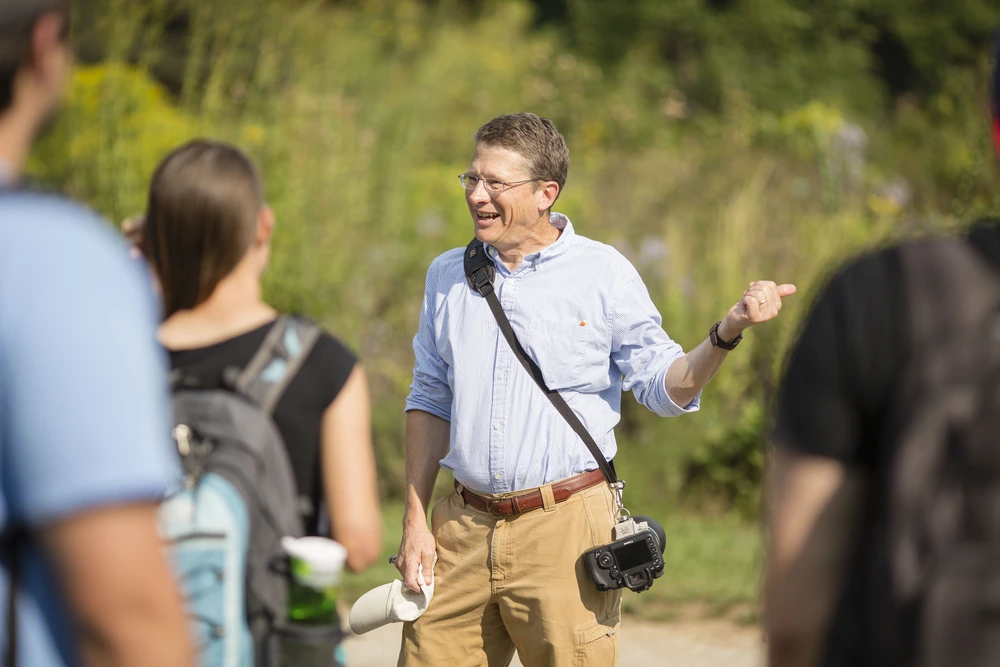
Rob Kanter believed the best education didn’t happen within four walls. Even when he stood in front of a classroom, he focused on the world beyond it.
For more than a decade, Kanter guided students not only through course readings but across landscapes—from the tropical rainforests of Central America to the prairies and forests of Central Illinois—using his deep curiosity and love for the environment to open their eyes to a richer understanding of the world around them. Now, as he retires, students and colleagues are reflecting on the impact of his distinctive approach to environmental education.
From the almanac to the classroom
Kanter didn’t start his career in environmental science. Armed with a PhD in English and years of teaching composition, he discovered early on that his passion lay elsewhere. “I realized I really didn’t want to work as an English teacher,” he admitted. So, he contacted the Prairie Rivers Network, hoping to volunteer and expand his horizons. There, he met Bruce Hannon, then-head of the Department of Geography, and conversations between the two would spark the idea that would become the Environmental Almanac, a radio segment and newspaper column that shared stories about sustainability, wildlife, and conservation from departments on campus.
“I loved talking to people and doing stuff and writing about it,” Kanter said. The show began with just three episodes and a simple pitch. The late Jay Pearce, who was then station manager at WILL, was receptive to the idea. “Let's give it a try," he said, “You’ve got three minutes of radio on Thursday afternoon.”
The Almanac became more than a broadcast—a vehicle for Kanter’s fieldwork, a bridge between academic expertise and public engagement, and a window into his evolving career.
Finding a home in SESE
Steve Marshak, former head of the School of Earth, Society, and Environment, recognized Kanter’s potential to bring something special to the school. “He’d been working on the Environmental Almanac, Marshak recalled, “which I thought might be fun to anchor in the school to give us more visibility.”
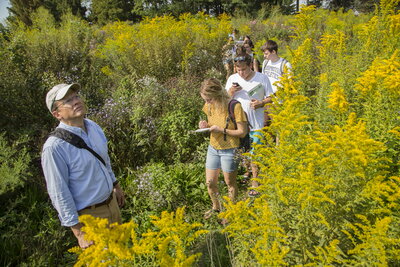
But visibility wasn’t enough. Marshak knew Kanter’s background in writing could benefit the interdisciplinary Environmental Sustainability major, and he urged Kanter to teach students “what he does”—writing about the environment with clarity, urgency, and insight.
“He was able to teach writing in context,” Marshak said. “Students could do their assignments on something they were interested in. Because he attached field experiences to these courses, he could put the concept of communication in context.”
That simple idea grew into something enduring: a full-fledged environmental writing program grounded in experience and dedicated to helping students find their voice. Students learned to craft narratives and essays about the natural world in the classroom. In the field, they learned to see that world—and their place in it—more clearly.
Teaching beyond the textbook
Kanter’s impact is also visible in the field courses he helped shape. A hallmark experience for many students is the Costa Rica Spring Break course—ten intensive days of exploration and discovery. Rob took charge of the course in 2014, but it has always been a collaborative effort. In recent years, he’s co-taught it with Professor Nooreen Meghani. Meghani saw firsthand how Kanter’s approach was transformative. “Rob’s the closest thing I’ve ever met to an old-school naturalist,” she said. “He has an incredible ability to talk about natural systems in a way that students connect with.”
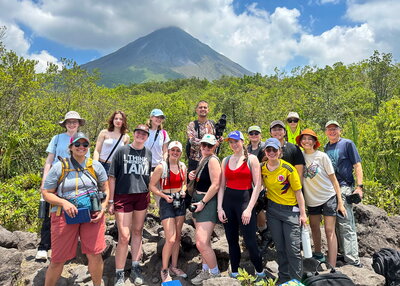
“It’s meaningful for students to make direct connections with people who are not professors,” Kanter said. “You hear all the little things that don’t come out in a lecture or video.”
Whether talking with farmers, engineers, or conservationists, students came away not just with facts but with context and perspective. “I suspect students will remember his encouragement for getting their work out there,” Meghani says. “He encourages them to a place where they can submit it—to Q, the Student Environmental Magazine. He takes it one step beyond the classroom and says, ‘Okay, now let’s take this outside.’ That’s really meaningful.”
Communicating for change
More than just a teacher, Rob became a catalyst. His environmental writing course wasn’t just a class but a doorway to experiential learning. Students ventured into the field to interview local environmentalists and community members, to see and feel the spaces they were writing about. “His arrival meant we were able to deliver experiential learning that we weren’t able to do before,” said Jonathan Tomkin, current head of the Environmental Sustainability program.
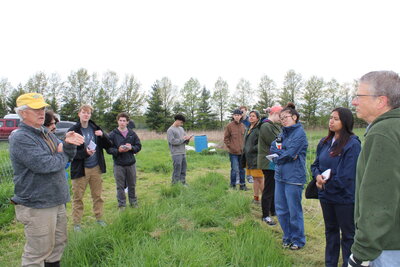
Rob’s network and curiosity extended into the wider university and community. He brought in guest speakers and collaborators from across campus—law, religion, and other departments—to enrich the interdisciplinary nature of sustainability. His passion for environmental heritage, especially the Midwest, inspired him to design immersive field trips to places like Baraboo and Costa Rica. “He had a passion and skill for taking students into a natural place and just having them experience it,” Tomkin recalls. “That’s where the deepest learning happens—when they’re immersed.”
Kanter’s writing classes didn’t just teach grammar or style. They taught how to see, how to understand, and how to care. He emphasized that students could—and should—be agents of change.
“Often, I think students are looking at the big picture so much that they can’t see a role for themselves,” Kanter said. “I want them to see people go to work every day and do something meaningful.”
Students might forget lectures, but they remember moments: holding binoculars while Rob pointed out a warbler, paddling through wetlands, sharing stories around a campfire. “They’ll tell you anecdote after anecdote of being with Rob somewhere,” Tomkin says. “To me, that’s proof of learning.”
A lasting legacy
Kanter’s legacy isn’t just the Environmental Almanac or the field trip courses. It’s in the way students leave class more curious, connected, and courageous.
“He seems to effortlessly navigate this world where you have to be both a mentor and someone that students trust—and someone who tells them when they’re messing up,” Meghani said. “And the students just love him for it.”

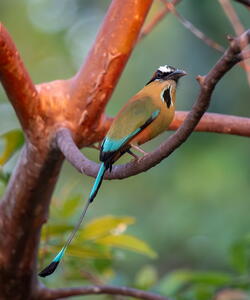
Anyone who’s been on a field trip with Rob Kanter probably has a bird story. Birdwatching wasn’t part of the syllabus when he designed his courses, but once they were out in the field, he couldn’t help but share what he saw. On his final outing as an educator, during a visit to a sustainable livestock farm, a student spotted an eagle overhead and called out excitedly. Kanter lit up—this was the third trip in a row they’d seen one.
His joy was unmistakable. That deep, infectious love for birds and the natural world didn’t just stick with students; it also shaped how his colleagues saw things. Meghani laughed when asked if he had turned her into a birder. “Spending time with someone so enthusiastic and knowledgeable about them is inspiring,” she said.
As Rob embarks on a new chapter—part of which will likely include following the birds wherever they may lead—his impact on the program is undeniable. “He’s done more to shape what we hope to do with the students than anybody,” says Tomkin. “There are a whole lot of students who are going to think of the degree and think of Rob.”